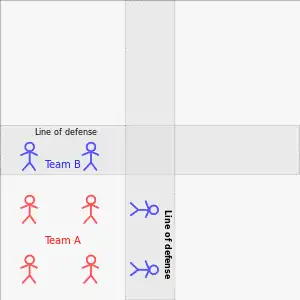
Surr[lower-alpha 1] is a tag sport that was once popular among children in villages of Awadh region in northern India.[2][3]
The game is played on a rectangular field, divided into four equal quadrants, by two teams of two to four players each.[1] The attacking team gathers in one quadrant, and the defending team gathers along the quadrant's borders with the adjoining quadrants. The objective of the attacking team is to enter the other quadrants without being touched by the players of the defending team. If all the members of the attacking team manage to enter all the quadrants, the attacking team wins, and its members shout "Bol Den Goivan Surr!".[3] In an Awadhi variation, they sing "Bol Goiyan Banva Surr" ("बोल गोइयां बणवा सुर्र");[1] if they are touched by the defending team, they lose, and have to stand on the quadrant line as "thieves", and have to sing another phrase.[2]
The game has declined in popularity, and is now almost extinct.[4]
See also
Notes
References
- 1 2 3 Suresh Gautam (2022). लोक साहित्य: ज्यों की त्यों धरि दीनी चदरिया [Lok Sahitya: Jyon Ki Tyon Rakh Dini Chadariya] (in Hindi). New Delhi: K.K. p. 141. OCLC 1035812603.
- 1 2 3 Vidya Vindu Singh (2021). अवधी लोकगीत विरासत [Awadhi Lokgeet Virasat] (in Hindi). Prabhat Prakashan / Gyan Vigyan Educare. pp. 210–211. ISBN 9789384344399.
- 1 2 Heather Ford (2022). "Ethnographies of the Digitally Dispossessed". In Elisabetta Costa; Patricia G. Lange; Nell Haynes; Jolynna Sinanan (eds.). The Routledge Companion to Media Anthropology. Routledge. doi:10.4324/9781003175605. ISBN 9781003175605.
- ↑ "विलुप्त हो गए सावन के खेल सुर्र और सिकड़ी". Dainik Jagran. 2014-07-20. Retrieved 2023-01-24.